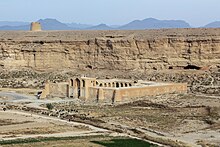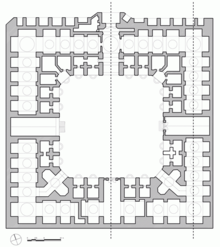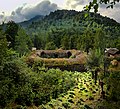Caravanserai

Acaravanserai(orcaravansary;/kærəˈvænsəˌraɪ/)[1]was a roadsideinnwhere travelers (caravaners) could rest and recover from the day's journey.[2]Caravanserais supported the flow of commerce, information and people across the network oftrade routescovering Asia,North AfricaandSoutheast Europe,most notably theSilk Road.[3][4]Often located along rural roads in the countryside, urban versions of caravanserais were also historically common in cities throughout theIslamic world,and were often called other names such askhan,wikala,orfunduq.[5]
Terms and etymology
[edit]
Caravanserai
[edit]Caravanserai (Persian:کاروانسرای,romanized:kārvānsarāy), is the Persian compound word variant combiningkārvān"caravan"with-sarāy"palace", "building with enclosed courts".[6]Here "caravan" means a group of traders, pilgrims or other travellers, engaged in long-distance travel. The word is also rendered ascaravansary,caravansaray,caravanseray,caravansara,andcaravansarai.[4]In scholarly sources, it is often used as an umbrella term for multiple related types of commercial buildings similar to inns or hostels, whereas the actual instances of such buildings had a variety of names depending on the region and the local language.[5]However, the term was typically preferred for rural inns built along roads outside of city walls.[7]
Khan
[edit]
The wordkhan(خان) derives from a clipping ofMiddle Persian:𐭡𐭩𐭲𐭠,romanized:xānag,lit. 'house'.[8][5]It could refer to an urban caravanserai built within a town or a city[5][9]or to any caravanserai in general, including those built in the countryside and along desert routes.[10]
In Turkish the word is rendered ashan.[5]The same word was used inBosnianand Bulgarian, having arrived through theOttoman conquest.In addition to Turkish and Persian, the term was widely used in Arabic as well, and examples of such buildings are found throughout the Middle East from as early as theUmayyad Caliphate.[5][9]The termhanis also used in Romanian being adopted from Ottoman Turkish.[citation needed]
Funduq
[edit]
The termfunduq(Arabic:فندق;sometimes spelledfoundoukorfondoukfrom theFrenchtransliteration) is frequently used for historic inns in Morocco and around theMaghreb.[5][11][12]: 116
The word comes fromKoinē Greek:πανδοκεῖον,romanized:welcoming all; an inn;[13][5]it appears asHebrew:פונדק,romanized:pundaq,fundacoinVenice,fondacoinGenoaandalhóndiga[14]orfondain Spanish. In the cities of this region such buildings were also frequently used as housing for artisan workshops.[15][11][16]: 318
Wikala
[edit]
The Arabic wordwikala(وكالة), sometimes spelledwakalaorwekala,is a term found frequently in historic Cairo for an urban caravanserai which housed merchants and their goods and served as a center for trade, storage, transactions and other commercial activity.[17]The wordwikalameans roughly "agency" inArabic,in this case a commercial agency,[17]which may also have been a reference to thecustomsoffices that could be located here to deal with imported goods.[18]The termkhanwas also frequently used for this type of building in Egypt.[5]
Okelle
[edit]The termokelleorokalle,theItalianizedrendering of the Arabic wordwikala,is used for a type of large urban buildings in 19th century Egypt, specifically inAlexandria.Here, the older Egyptianwikalawas reinterpreted in anItalianatestyle by the Italian architectFrancesco Mancini.Directed byMuhammad Ali,he designed and built a number ofokelles delineating thePlace des Consuls(the main square of Alexandria's European quarter), which served as consular mansions, a European-style hotel, and a stock exchange, among other functions.[19]
Katra
[edit]Kāṭrā(Bengali:কাটরা) is the name given to the caravanserais built by theMughal EmpireinBengal.TheBara Katra(Bengali:বড় কাটরা,romanized:Baṛa Kāṭrā,lit. 'Great Caravanserai') andChhota Katra(Bengali:ছোট কাটরা,romanized:Chōṭa kāṭrā,lit. 'Small Caravanserai') refers to two magnificentMughalkatras inDhaka,Bangladesh.[20][21][22][23][24]
History
[edit]
Caravanserais were a common feature not only along the Silk Road, but also along theAchaemenid Empire'sRoyal Road,a 2,500-kilometre-long (1,600 mi) ancient highway that stretched fromSardistoSusaaccording toHerodotus:"Now the true account of the road in question is the following: Royal stations exist along its whole length, and excellent caravanserais; and throughout, it traverses an inhabited tract, and is free from danger."[25]Other significant urban caravanserais were built along theGrand Trunk Roadin theIndian subcontinent,especially in the region ofMughalDelhiandBengal Subah.
Throughout most of theIslamic period(seventh century and after), caravanserais were a common type of structure both in the rural countryside and in dense urban centers across theMiddle East,North Africa,andOttomanEurope.[5]A number of 12th to 13th-century caravanserais orhans were built throughout theSeljuk Empire,many examples of which have survived acrossTurkeytoday[26][27](e.g. the largeSultan HaninAksaray Province) as well as inIran(e.g. theRibat of SharafinKhorasan province). Urban versions of caravanserais also became important centers of economic activity in cities across these different regions of the Muslim world, often concentrated near the mainbazaarareas, with many examples still standing in the historic areas ofDamascus,Aleppo,Cairo,Istanbul,Fes,etc.[28][29][30][31][16]
Ibn Battuta,a 14th-century Muslim traveler, described the function of a caravenserai in the region of China:
China is the safest and best country for the traveller. A man travels for nine months alone with great wealth and has nothing to fear. What is responsible for this is that in every post station in their country isfunduqwhich has a director living there with a company of horse and foot. After sunset or nightfall the director comes to thefunduqwith his secretary and writes down the names of all the travellers who will pass the night there, seals it and locks the door of thefunduq.In the morning he and his secretary come and call everybody by name and write down a record. He sends someone with the travellers to conduct them to the next post station and he brings back a certificate from the director of thefunduqconfirming that they have all arrived. If he does not do this he is answerable for them. This is the procedure in every post station in their country from Sin al-Sin to Khan Baliq. In them is everything the traveller needs by way of provisions, especially hens and geese. Sheep are rare among them.[32]
In many parts of the Muslim world, caravanserais also provided revenues that were used to fund charitable or religious functions or buildings. These revenues and functions were managed through awaqf,a protected agreement which gave certain buildings and revenues the status ofmortmainendowments guaranteed underIslamic law.[33][34]Many major religious complexes in theOttomanandMamlukempires, for example, either included a caravanserai building (like in thekülliyeof theSüleymaniye Mosquein Istanbul) or drew revenues from one in the area (such as theWikala al-Ghuriin Cairo, which was built to contribute revenues for the nearbycomplex of Sultan al-Ghuri).[31][30][35]
Architecture
[edit]
Most typically a caravanserai was a building with a square or rectangular walled exterior, with a single portal wide enough to permit large or heavily laden beasts such ascamelsto enter. The courtyard was almost always open to the sky, and the inside walls of the enclosure were outfitted with a number of identicalanimal stalls,bays, niches or chambers to accommodate merchants and their servants, animals, and merchandise.[36]
Caravanserais provided water for human and animal consumption, washing andritual purificationsuch aswuduandghusl.Sometimes they had elaborate public baths (hammams), or other attached amenities such as a fountain or asabil/sebil.They keptfodderfor animals and had shops for travellers where they could acquire new supplies. Some shops bought goods from the travelling merchants.[37]Many caravanserais were equipped with small mosques, such as the elevated examples in the Seljuk and Ottoman caravanserais in Turkey.[31][38][30]
In Cairo, starting in theBurji Mamlukperiod,wikalas (urban caravanserais) were frequently several stories tall and often included arab',a low-income rental apartment complex, which was situated on the upper floors while the merchant accommodations occupied the lower floors.[39][29]While making the best use of limited space in a crowded city, this provided the building with two sources of revenue which were managed through thewaqfsystem.[34][40]
Notable caravanserais
[edit]Alphabetically, not taking article (al-, el-, etc.) into consideration.
- Abbasi Hotel,Isfahan,Iran
- Ağzıkara Han,Ağzıkarahan (Aksaray Province),Turkey
- Akbari Sarai,Lahore,Pakistan
- Aminoddole Carvansarai,in theKashan Bazaar,Kashan,Iran
- Bara Katra,Dhaka, Bangladesh
- Büyük Han,Nicosia, Cyprus
- Büyük Valide Han,Istanbul, Turkey
- Büyük Yeni Han,Istanbul, Turkey
- Caravanserai of Sa'd al-Saltaneh,Qazvin, Iran
- Caravanserai of Zor,Iğdır, Turkey
- Chhota Katra,Dhaka, Bangladesh
- Corral del Carbón,Granada, Spain
- Elbasan Han,Korçë, Albania
- Funduq Nejjarine,Fes, Morocco
- Funduq Sagha,Fes, Morocco
- Funduq Shamma'in,Fes, Morocco
- Funduq Staouniyyin,Fes, Morocco
- Garghabazar Caravanserai,Kharabakh, Azerbaijan
- Hasan Pasha Han, Diyarbakır,Turkey
- Kapan Han,Skopje, North Macedonia
- Khan As'ad Pasha,Damascus, Syria
- Khan Jaqmaq,Damascus, Syria
- Khan el-Khalili,Cairo, Egypt
- Khan Sulayman Pasha,Damascus, Syria
- Khan al-Tujjar,Mount Tabor, Israel
- Khan al-Tujjar,Nablus, West Bank
- Khan Tuman,Damascus, Syria
- Khan al-Umdan,Acre, Israel
- Koza Han,Bursa, Turkey
- Kürkçü Han,Istanbul, Turkey
- Kuršumli An,Skopje, North Macedonia
- Manuc's Inn,Bucharest, Romania
- Morića Han,Sarajevo, Bosnia and Herzegovina
- Multani Caravanserai,Baku, Azerbaijan
- Mughal Sarai, Surat,Gujarat, India
- Nampally Sarai,Nampally, Hyderabad, India
- Orbelian's Caravanserai,Armenia
- Rabati Malik,Uzbekistan
- Shaki Caravanserai,Shaki,Azerbaijan
- Stari Han,Kremna, Užice, Serbia
- Suli An,Skopje, North Macedonia
- Sultan Han,Sultanhanı (Aksaray Province), Turkey
- Sultan Han,Sultanhanı (Kayseri Province), Turkey
- Wikala al-Ghuri,Cairo, Egypt
- Wikala Qaytbay (at al-Azhar),Cairo, Egypt
- Wikala Qaytbay (at Bab al-Nasr),Cairo, Egypt
- Zeinodin Caravanserai,Zein-o-din, Yazd, Iran
Gallery
[edit]This sectioncontains an unencyclopedic or excessive gallery of images. |
-
An 1850 drawing ofKhan al-Tujjar,nearMount Tabor,Israel
-
Khan al-Wazir,Aleppo,Syria
-
Inside theOrbelian's Caravanserai,Armenia
-
The caravanserai of Shah Abbas, nowAbbasi Hotel,inIsfahan,Iran. View is from the courtyard (sahn).
-
An abandoned caravanserai inNeyestānak,Iran
-
An 1823 etching ofBara Katra,or Great Caravanserai, inDhaka,Bangladesh;built by theMughalPrince Shah Shuja
-
An 1817 sketch of theChoto Katracaravanserai in Dhaka, Bangladesh; built by the Mughal viceroyShaista Khan
-
Anderkilla inChittagong,Bangladesh
-
Panoramic view of the roof of Dirgchin Caravanserai in Qom Province, surviving architecture from the Sassanid period
See also
[edit]- List of caravanserais
- Ribat,Early Muslim frontier fort, later caravanserai or Sufi retreat
- Robat,the Persian word for ribat
- Bedesten,type of covered Ottoman market or market hall
- Caravan city
- Islamic architecture
- Shukuba,the Japanese equivalent
- Rest area
- Motel
- Venta,the Spanish equivalent
- Roadhouse
References
[edit]- ^"Dictionary – caravansary".Archivedfrom the original on 12 December 2019.Retrieved31 January2016.)
- ^Chisholm, Hugh,ed. (1911)..Encyclopædia Britannica(11th ed.). Cambridge University Press.
- ^"Caravanserais: cross-roads of commerce and culture along the Silk Roads | Silk Roads Programme".en.unesco.org.Archivedfrom the original on 29 May 2020.Retrieved17 June2020.
- ^ab"Caravanserai".National Geographic Society. 23 July 2019.Archivedfrom the original on 29 July 2020.Retrieved17 June2020.
- ^abcdefghijM. Bloom, Jonathan; S. Blair, Sheila, eds. (2009). "Caravanserai".The Grove Encyclopedia of Islamic Art and Architecture.Oxford University Press.ISBN978-0-19-530991-1.
- ^"caravanserai | Origin and meaning of caravanserai by Online Etymology Dictionary".etymonline.Archivedfrom the original on 18 June 2020.Retrieved17 June2020.
- ^"Caravansary | building".Encyclopedia Britannica.Archivedfrom the original on 27 July 2020.Retrieved17 June2020.
- ^MacKenzie, D. N.(1971), "xān", inA concise Pahlavi dictionary,London, New York, Toronto: Oxford University Press, p. 93.
- ^ab"Khan | architecture".Encyclopedia Britannica.Archivedfrom the original on 27 July 2020.Retrieved17 June2020.
- ^Petersen, Andrew (1996). "khan".Dictionary of Islamic architecture.Routledge. pp. 146–147.ISBN9781134613663.
- ^abTouri, Abdelaziz; Benaboud, Mhammad; Boujibar El-Khatib, Naïma; Lakhdar, Kamal; Mezzine, Mohamed (2010).Le Maroc andalou: à la découverte d'un art de vivre(in French) (2 ed.). Ministère des Affaires Culturelles du Royaume du Maroc & Museum With No Frontiers.ISBN978-3902782311.
- ^Wilbaux, Quentin (2001).La médina de Marrakech: Formation des espaces urbains d'une ancienne capitale du Maroc(in French). Paris: L'Harmattan.ISBN2747523888.
- ^"Strong's Greek: 3829. πανδοχεῖον (pandocheion) -- an inn".biblehub.Archivedfrom the original on 29 December 2014.Retrieved19 February2015.
- ^"alhóndiga in the Diccionario de la Real Academia Española".Archivedfrom the original on 6 August 2017.Retrieved25 April2015.
- ^Parker, Richard (1981).A practical guide to Islamic Monuments in Morocco.Charlottesville, VA: The Baraka Press.
- ^abLe Tourneau, Roger (1949).Fès avant le protectorat: étude économique et sociale d'une ville de l'occident musulman(in French). Casablanca: Société Marocaine de Librairie et d'Édition.
- ^abHathaway, Jane (2008).The Arab Lands under Ottoman Rule: 1516-1800.Routledge. p. 141.ISBN9780582418998.
- ^AlSayyad, Nezar (2011).Cairo: Histories of a City.Cambridge, MA: The Belknap Press of Harvard University Press. pp.143.ISBN978-0-674-04786-0.
- ^Pallini, Cristina (2006). "Italian Architects and Modern Egypt".Studies in Architecture, History & Culture: Articles by the 2003-2004 AKPIA@MIT Visiting Post-Doctoral Fellows(PDF).Aga Khan Program for Islamic Architecture at MIT. pp. 39–50.
- ^Mamun, Muntasir.Dhaka: Smriti Bismritir Nagariঢাকা: স্মৃতি বিস্মৃতির নগরী[Dhaka: City of Memories and Oblivion] (in Bengali) (3rd ed.). pp. 201–206.ISBN984-412-104-3.
- ^Rahman, Mahbubur.City of an Architect.Dhaka: Delvistaa Foundation.ISBN978-984-33-2451-1.
- ^Ahmed, Nazimuddin (1980).Islamic Heritage of Bangladesh.Dacca: Ministry of Information and Broadcasting, Government of the People's Republic of Bangladesh. pp. 50–51.OCLC8476199.
- ^Asher, Catherine B (1984).Inventory of Key Monuments. Art and Archaeology Research Papers: The Islamic Heritage of Bengal.Paris:UNESCO.
- ^Hasan, S. Mahmudul (1980).Muslim Monuments of Bangladesh.Dhaka:Islamic Foundation.
- ^"The History - Herodotus" -http://classics.mit.edu/Herodotus/history.mb.txtArchived29 June 2011 at theWayback Machine
- ^"Seljuk Caravanserais".Archnet.Archivedfrom the original on 18 June 2020.Retrieved17 June2020.
- ^"Seljuk Caravanserais on the route from Denizli to Dogubeyazit".UNESCO World Heritage Centre.Archivedfrom the original on 22 June 2020.Retrieved17 June2020.
- ^"Khans of Damascus".Archnet.Archivedfrom the original on 18 June 2020.Retrieved17 June2020.
- ^abWilliams, Caroline (2018).Islamic Monuments in Cairo: The Practical Guide(7th ed.). Cairo: The American University in Cairo Press.
- ^abcKuban, Doğan (2010).Ottoman Architecture.Antique Collectors' Club.
- ^abcSumner-Boyd, Hilary; Freely, John (2010).Strolling Through Istanbul: The Classic Guide to the City.Tauris Parke Paperbacks.
- ^Gibb 2010,p. 894.
- ^"Waḳf".Encyclopaedia of Islam, Second Edition.Brill. 2012.
- ^abBehrens-Abouseif, Doris. 2007.Cairo of the Mamluks: A History of Architecture and its Culture.Cairo: The American University in Cairo Press.
- ^"Wakala Qansuh al-Ghawri".ArchNet.Archivedfrom the original on 3 January 2018.Retrieved2 January2018.
- ^Sims, Eleanor. 1978. Trade and Travel: Markets and Caravansary.' In: Michell, George. (ed.). 1978.Architecture of the Islamic World - Its History and Social Meaning.London: Thames and Hudson Ltd, 101.
- ^Ciolek, T. Matthew. 2004-present.Catalogue of Georeferenced Caravansaras/KhansArchived2005-02-07 at theWayback Machine.Old World Trade Routes (OWTRAD) Project. Canberra: ciolek - Asia Pacific Research Online.
- ^Freely, John (2008).Storm on Horseback: The Seljuk Warriors of Turkey.I. B. Tauris.
- ^Yeomans, Richard (2006).The Art and Architecture of Islamic Cairo.Reading: Garnet. pp.230-231.ISBN978-1-85964-154-5.
- ^Denoix, Sylvie; Depaule, Jean-Charles; Tuchscherer, Michel, eds. (1999).Le Khan al-Khalili et ses environs: Un centre commercial et artisanal au Caire du XIIIe au XXe siècle(in French). Cairo: Institut français d'archéologie orientale.
- ^Vladimir Braginskiy. Tourist Attractions in the USSR: A Guide. Raduga Publishers, 1982. 254 pages. Page 104.
"The whole of the centre of Sheki has been proclaimed a reserve protected by the state. To take you back to the time of the caravans, two large eighteenth-century caravanserais have been preserved with spacious courtyards where the camels used to rest, cellars where goods were stored, and rooms for travellers."
Further reading
[edit]- Branning, Katharine. 2018.turkishhan.org,The Seljuk Han in Anatolia. New York, USA.
- Cytryn-Silverman, Katia. 2010.The Road Inns (Khans) in Bilad al-Sham.BAR (British Archaeological Reports), Oxford.ISBN9781407306711
- Kīānī, Moḥammad-Yūsuf; Kleiss, Wolfram (1990)."Caravansary".Encyclopaedia Iranica, Vol. IV, Fasc. 7.pp. 798–802.
- Erdmann, Kurt, Erdmann, Hanna. 1961.Das anatolische Karavansaray des 13. Jahrhunderts,3 vols. Berlin: Mann, 1976,ISBN3-7861-2241-5
- Gibb, H.A.R. (2010),The Travels of Ibn Battuta, AD 1325-1354, Volume IV
- Hillenbrand, Robert. 1994.Islamic Architecture: Form, function and meaning.New York: Columbia University Press. (see Chapter VI for an in depth overview of the caravanserai).
- Kiani, Mohammad Yusef. 1976.Caravansaries in Khorasan Road.Reprinted from:Traditions Architecturales en Iran,Tehran, No. 2 & 3, 1976.
- Schutyser, Tom. 2012.Caravanserai: Traces, Places, Dialogue in the Middle East.Milan: 5 Continents Editions,ISBN978-88-7439-604-7
- Yavuz, Aysil Tükel. 1997.The Concepts that Shape Anatolian Seljuq Caravansara.In: Gülru Necipoglu (ed). 1997.Muqarnas XIV: An Annual on the Visual Culture of the Islamic World.Leiden: E. J. Brill, 80–95. [archnet.org/library/pubdownloader/pdf/8967/doc/DPC1304.pdf Available online as a PDF document, 1.98 MB]
External links
[edit]- Shah Abbasi Caravanserai, Tishineh
- Caravansara Pictures
- Consideratcaravanserai.net,Texts and photos on research on caravanserais and travel journeys in Middle East and Central Asia.
- Caravanserais (Kervansaray) in Turkey
- The Seljuk Han in Anatolia
- Persian Caravanserai,UNESCO application











![18th-century[41] caravanserai in Sheki, Azerbaijan](https://upload.wikimedia.org/wikipedia/commons/thumb/5/5e/Caravanserai-Sheki.jpg/120px-Caravanserai-Sheki.jpg)











